Site Menu:
| This is an archived Horseadvice.com Discussion. The parent article and menus are available on the navigation menu below: |
| HorseAdvice.com » Diseases of Horses » Cardiovascular, Blood, and Immune System » Equine Granulocytic Ehrlichiosis » |
| Discussion on Swelling from possible tick bite. | |
| Author | Message |
| Member: lsweeney |
Posted on Saturday, Jan 7, 2012 - 7:25 pm: I have three horses, all of which have experienced a swollen spot on their underside. One subsided when I found two ticks and pulled them off. The other was experiencing a large swelling on one teat that got very big and tight. Edema ran along the belly, and eventually, there was some draining right behind the belly button. I located a tick in the crease between the stifle and the belly. I pulled it off, and it has been slowly going down.At the same time, our third horse had a swelling starting in the same place - the crease between the stifle and the belly. There was a small scab in the center which is probably where a tick was attached. She was sensitive and didn't want me touching it. I have yet to actually find a tick on her. I called the vet out to eliminate pigeon fever. She didn't think it was pigeon fever given the location. At the time, the horse that was the worst did not have a fever. She gave the worst horse some bute, but didn't want to give any antibiotics because she felt it would discourage the abscesses from coming to a head. I then found a tick on this horse, and she has steadily improved. Several days have passed, and now the 3rd horse is very stiff on the one leg. The area in the crease has swollen and popped slightly and drained a small amount of pus. There is edema in the belly, and there is swelling below the stifle in the affected leg. She is running a 103.5 fever. I have cold-hosed it and removed any scabs from where it had drained hoping that it might drain further, but it appears to be done with that. She appears to be slightly off, mostly from being uncomfortable, but is not off feed and bright otherwise. This horse has been in kidney failure in the past, so I don't want to give her anything unless it is absolutely necessary. I will post pictures. Thoughts? |
| Member: lsweeney |
Posted on Saturday, Jan 7, 2012 - 7:32 pm: 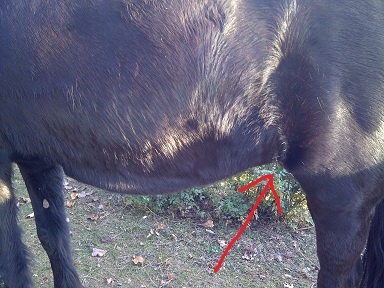
|
| Member: lsweeney |
Posted on Saturday, Jan 7, 2012 - 7:33 pm: 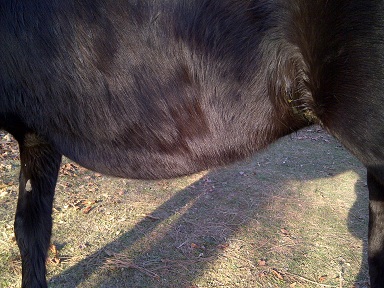
|
| Member: lsweeney |
Posted on Saturday, Jan 7, 2012 - 7:34 pm: The yellow in this picture in ointment, but that is where it was draining. The whole stifle area and above is swollen and very hard to the touch. The whole area in the crease is big and tight.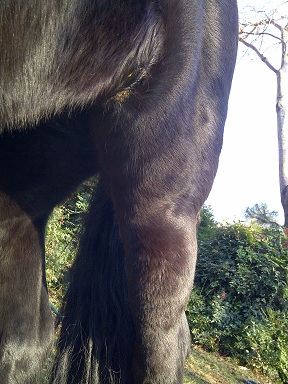
|
| Member: paul303 |
Posted on Monday, Jan 9, 2012 - 12:10 am: Living in a really bad tick area, I will say that I've experienced some pretty bad reactions on my horses...especially when it's near the tender belly tissue. I've noticed that bites from Lone Star ticks are really ugly.Since you found ticks, it certainly would indicate the possibility of ticks being involved. Some horses have greater reactions than others. When I get a bad one, I hot soak it twice a day until it opens ( don't squeeze )and drains. Then I top it with an antibiotic cream. I usually see a good change in a few days. |
| Member: vickiann |
Posted on Monday, Jan 9, 2012 - 2:31 pm: Laurie,I have seen photos of pigeon fever in this very location that the red arrow points to, including a description that this is one of the locations where it tends to appear. I forget the technical name of this location but it is where the leg meets the belly. Just near the belly button is another location where one may see pigeon fever. That said, it sounds like you may well have some kind of bug or tick bite situation. If you have multiple horses with problems it might be worthwhile to get a biopsy of the drainage so you know what you are dealing with if the problem persists. |
| Member: lsweeney |
Posted on Monday, Jan 9, 2012 - 5:40 pm: I'm not sure what the difference is between Pigeon Fever which is a bacteria that is carried by an insect bite, and a tick bite that is transferring some other evil doer? From what I can tell, both are creating an infection that is ending with an abscess?I did cold water hosing and then hot epsom salts soaking with a towel. I also walked her which forces her to use the leg moving back and forth where the abscess is. Her fever went down that night and has stayed down. She is still stiff in the leg. I think the swelling has gone down. There is no draining. Anybody see any need for antibiotics at this point? |
| Member: vickiann |
Posted on Monday, Jan 9, 2012 - 7:28 pm: I don't, but I am not a Veterinarian. |
| Member: lsweeney |
Posted on Monday, Jan 9, 2012 - 11:41 pm: Tonight she is still pretty lame because it hurts to move that back leg with this abscess inhibiting movement.So I soaked some more with hot epsom salts, covering the area with a hot towel as hot as I could stand it. This does seem to provide some relief. Temperature 101.3 and then 101.2 after walking for about 10-15 minutes. Regarding the location, I will say that the tick I found on the other horse is exactly in the same spot. So I don't know if it is a favored tick location? |
| Member: lsweeney |
Posted on Tuesday, Jan 10, 2012 - 11:16 am: 100.3 This AM. Walking a little better. Definitely does better after the hot epsom salt packs.Area in the crease still pretty full and hard. No evidence that it is coming to a head. So I don't know if she is doing better because I have pulled some of the moisture out of the area with the epsom salts? My other mare still has one teat that is pretty rock hard, but it appears to be slowly receding. Do these things have to be lanced or can they slowly dissipate? |
| Member: judyhens |
Posted on Tuesday, Jan 10, 2012 - 2:59 pm: So sorry Laurie. We live in Texas and have had an epidemic of pigeon fever this year. I think we ourselves had 7 cases. Several presented somewhat similar to yours. Hard abcesses that ultimately ruptured. No antibiotics. If your vet thinks they have abscesses caused by ticks, I guess the treatment would be similar. Dr. O?Good Luck! |
| Member: lsweeney |
Posted on Tuesday, Jan 10, 2012 - 3:34 pm: What was the time frame? |
| Member: judyhens |
Posted on Tuesday, Jan 10, 2012 - 6:07 pm: It varied greatly. For some, they ruptured in a few days. For several it took a long time - maybe even a few weeks for all to come to a head and rupture. The lower on the abscess the rupture occurred, it seemed the faster they healed over-all. We had one stallion whose abscess ruptured at the top, creating a huge pocket which continually filled with pus despite being flushed. Ultimately the skin sloughed off leaving a gaping wound. That took the longest to heal. They didn't want to lance it when it was quite deep, so we pretty much had to wait everything out. Then used Vetericyn (vet strength)and everyone recovered completely. Horrible thing to deal with, but apparently not typically life threatening. Not sure about tick bites, though. good luck, Laurie! |
| Member: lsweeney |
Posted on Wednesday, Jan 11, 2012 - 2:41 pm: She seems to do better after the epsom salt hot packs, so the vet has asked me to do this twice a day.I came up with an idea. I really didn't want to lather ichthammol ointment all over this large place as I was afraid of the impact on the skin (but I have seen suggestions to use this to draw out the abscess). I had another clay-like poultice product that I thought would be less caustic. This area is so hard because there is really no way to bandage it. So I mixed the clay poultice in with some water and betadine solution, and made a thick, gravy like solution. I then rubbed that all over the area, and with her winter coat, it is sticking. I'm curious what kind of impact it will have. |
| Moderator: DrO |
Posted on Wednesday, Jan 11, 2012 - 6:42 pm: Hello Laurie,Your first post describes an abscess in this leg and if it continues to be swollen and painful most likely it is not draining well. While icthammol helps bring a abscess to a head the best treatment would be surgically enlarging the drainage area. For more on this see HorseAdvice.com » Diseases of Horses » Skin Diseases, Wounds, and Swellings » Swellings / Localized Infection / Abscesses » Abscesses and Localized Infection. DrO |
| Member: lsweeney |
Posted on Wednesday, Jan 11, 2012 - 11:53 pm: Well, I'm inclined to agree. She looked uncomfortable tonight. No real progress with the abscess. Temperature: 102.5 DrOpping to 101.5 eventually, and will probably be lower when I check it again here shortly.Looks like we are taking a ride to the vet tomorrow. |
| Member: lsweeney |
Posted on Friday, Jan 13, 2012 - 3:01 pm: Went to UC Davis yesterday. I took both of the Friesians. They think it is pigeon fever even though it may have originated from a tick bite. Not that the tick carried it, but there may have been a wound that the flies transmitted the bacteria into? We are having the blood tested to confirm.They ultrasounded the abscess on the mare who has been running the fever - Nikki. The black areas on the ultrasound represent fluids (pus). 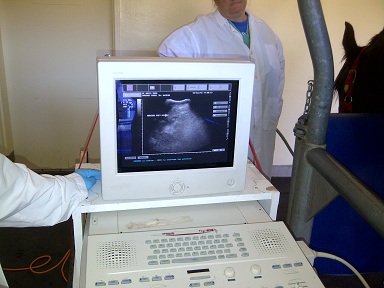
|
| Member: lsweeney |
Posted on Friday, Jan 13, 2012 - 3:06 pm: Using the ultrasound machine they inserted a syringe into the suspected pus pocket, and then withdrew some pus to ensure that they had hit the correct area. Then they took a scalpel and followed the syringe needle to open up the abscess. While it drained quite a bit of material, it wasn't as prolific as some of the pictures and videos I have seen.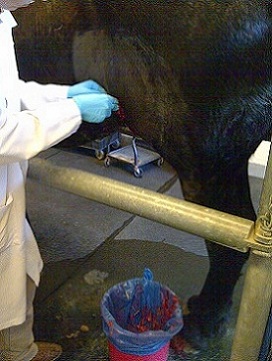
|
| Member: lsweeney |
Posted on Friday, Jan 13, 2012 - 3:09 pm: My instructions are now to reach inside the wound and pull out any pus material, keep the incision open, and flush it with a betadine water solution for about a week, twice a day.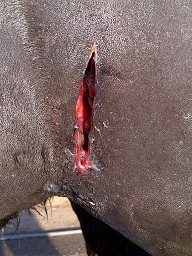
|
| Member: lsweeney |
Posted on Friday, Jan 13, 2012 - 3:39 pm: She is not on any antibiotics. They gave her some banamine yesterday. They said that I could give her some banamine and that might help cleaning the wound.I tried it without the banamine and she was fine. She is bright, almost skipping down the hill for her feed. Completely different horse. She was really good while I cleaned out her abscess. It is nowhere near as painful as it was with the swelling intact. On my other Friesian that still has quite a large abscess in the teat area, they ultrasounded it, and found only a small pocket of pus. So they didn't feel it was worth lancing. She was not running a fever and on her own, eliminated the edema on her belly, and appears to be very slowly on the mend. They said that they are monitoring over 100 cases of pigeon fever right now in Northern California. I will be interested on what the blood tests reveals. |
| Member: vickiann |
Posted on Saturday, Jan 14, 2012 - 9:50 am: Glad to hear that things seem to be improving!Please let us know how this progresses. |
| Member: lsweeney |
Posted on Sunday, Jan 15, 2012 - 8:36 pm: This is an ugly, ugly wound. I can put my finger all of the way up inside of her leg. I'm not seeing chunks of pus, just oozing.Her fever has been normal, except tonight when it was creeping up to 101.7. Also, she was less perky today and looked more sore again. Yesterday I took her for a walk (in hand). She pranced around a little when I got away from the other horses. She moved around quite a bit when I put her back in the pasture. (Not running, just noticed that she was here and there, instead of just hanging out. So I don't know if the moving around (which squeezes the abscess area) created some bruising/pain? Anyway, she seemed a little more off today from the last two days, and I don't like that her temperature is threatening to having a fever even if very low. What types of things should I be concerned about with this giant hole that I'm flushing twice a day with a betadine water? They told me to keep it open, but it doesn't look like it is even thinking about closing? What would be the normal time frame for something like this to heal? I haven't gotten the blood test results back for a positive Pigeon Fever diagnosis. 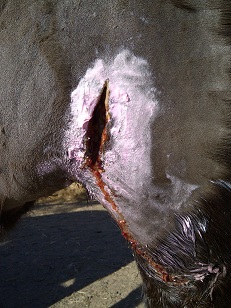
|
| Member: judyhens |
Posted on Monday, Jan 16, 2012 - 3:56 pm: Although our stallion's abscess wasn't lanced, it was close to a dessert dish size open wound deep enough to put a fist in when it finally opened up. Because we have so many horses on the property and were concerned about flies contaminating the wound and biting another horse, our horse was hospitalized and isolated. The wound healed from the inside out, and was pretty much closed with hair growing back in a month. It was horrific. Hard to actually believe how quickly things can turn around and heal. How marvelous nature is! Good luck and keep us posted. How is the fever today? :-) |
| Member: lsweeney |
Posted on Monday, Jan 16, 2012 - 11:59 pm: Judy that makes me feel much better!!!Normal today. 99.6 and 100.4 tonight. She's feeling well enough that she almost pulled my deck down when she decided she was done with the flushing. We are now developing an "attitude". My husband is out of town, so I have to do this myself. He will be back Wednesday. It's in the 20s here, and both of us were all wet after I entered the wound flushing war zone tonight. |
| Member: lsweeney |
Posted on Tuesday, Jan 17, 2012 - 1:58 pm: After a come to Jesus meeting last night, we stood like an angel this morning. Temperature still normal, and while hosing, I was actually getting some lip action, so I think it is starting to itch and the hosing now feels good. |
| Member: paul303 |
Posted on Tuesday, Jan 17, 2012 - 5:03 pm: Good luck, Laurie, and I hope that wound will start closing - from the inside, out - soon. Any blood test results yet?If it was lanced just four days ago, it'll take a little time. You need patience and diligence, for a number of days, yet. But once it starts to close, it usually happens fairly quickly. |
| Member: lsweeney |
Posted on Tuesday, Jan 17, 2012 - 6:27 pm: Still waiting on the pigeon fever test results. |
| Member: lsweeney |
Posted on Saturday, Jan 28, 2012 - 6:30 am: Well, both horses are positive for pigeon fever. So I really would like to know the connection of the tick bites and pigeon fever. I was able to find one post on the web with a woman with a horse that had a tick bite and an abscess. UC Davis seemed to believe it wasn't possible for the ticks to carry the disease, and yet we had very few flies. It was dry and brisk.The horses have been nowhere off my property. I have been there for 20 years with no case of pigeon fever. I do have some burros and other horses several acres away but they have not been sick. So very weird to have all 3 of my horses with swellings, 2 with ticks and 1 with a spot that looked like a tick bite and 2 with abscesses and positive for pigeon fever. The one not tested still has welts where I found the ticks, but never abscessed. |
| Member: lsweeney |
Posted on Saturday, Jan 28, 2012 - 6:35 am: The wound is healing well. Only slightly draining now.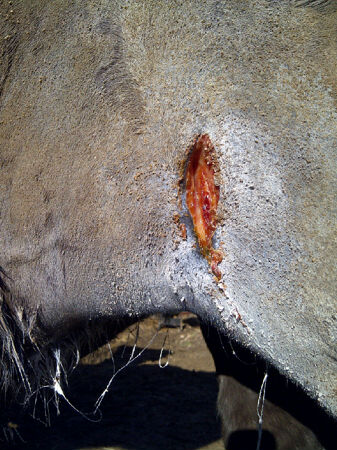
|
| Member: vickiann |
Posted on Saturday, Jan 28, 2012 - 9:33 pm: Happy to hear that you finally have some test results. It may not seem like much sometimes, but having tests that give answers is really a major advantage. Hoping that the healing progresses well. |
| Member: lsweeney |
Posted on Sunday, Jan 29, 2012 - 2:37 pm: Well, the vet said that the tests indicated that we were most likely dealing with external abscesses. Additionally, I can tell my neighbors with horses that it is pigeon fever. And finally, if my 3rd horse comes up with something or if the horses present another abscess, we will know that it is most likely pigeon fever.In talking with a friend, we were wondering if the transmission could be from soil that is in the horses' coats already? So the horses are dusty and dirty, the tick bites, and it doesn't have to be a fly transmitting it. The soil with the bacteria is already on the horse, and can gain entry as the tick wound opens? What is very unusual is that we didn't have any serious rain until the end of January. So we had a very cold, dry environment. This bacteria likes dry environments and mild winters. They are usually suppressed once winter hits. The ticks are not out until winter sets in. Under these current conditions, the ticks and the bacteria are hanging out at the same time, which is unusual. Perhaps this is one of the reasons for the connection? |
| Member: paul303 |
Posted on Sunday, Jan 29, 2012 - 11:28 pm: Boy, Laurie, I see you are from California. Being located in the Pine Barrens of N.J., I really can't relate. Hopefully, you can see your way through this. It's certainly a tough row to hoe.I've known of a horse nearby with pigeon fever, but it was in the warmer months. You said that the ticks were not out until winter sets in....we don't get a lot of tick activity until the temperatures get above 40 and stay that way. Our misery is in spring, summer, and fall. At any rate, heartfelt good wishes to you. Stay strong, you'll get through this. |
| Member: lsweeney |
Posted on Monday, Jan 30, 2012 - 12:35 am: Our ticks usually come out when it gets cooler and wet. We do have some summer varieties, but the most activity is usually after the first rain. |
| Moderator: DrO |
Posted on Wednesday, Feb 1, 2012 - 4:07 pm: Hello Laurie,They should not say the ticks cannot cause the infection, more accurate is we do not have any information on ticks and PF. If there is a wound created where there is skin contaminated with viable PF organisms infection is certainly a possibility. DrO |
| Member: lsweeney |
Posted on Saturday, Feb 4, 2012 - 5:29 pm: Thank you, Dr. O. I just can't believe that there is some connection. Regardless, I'm thinking fly spray would be a preventative as it will repel the ticks too. |
| Member: lsweeney |
Posted on Saturday, Feb 4, 2012 - 6:00 pm: Filling in!!!!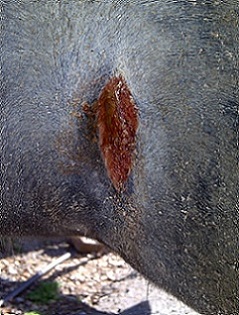
|
| Member: canter |
Posted on Sunday, Feb 5, 2012 - 2:02 pm: Wow, Laurie - that looks so much better! Kudos to your TLC. |
| Member: lsweeney |
Posted on Tuesday, Feb 7, 2012 - 1:32 pm: Thanks Fran. I like posting the result, because a lot of times on these articles, you are left hanging with what happened.As a side note, I just got off the phone with another resident in the area with a horse, that had a tick, and now an abscess. I think there is definitely a tick connection. |
| Member: vickiann |
Posted on Tuesday, Feb 7, 2012 - 9:25 pm: We truly appreciate when folks update.Thanks, Laurie. Hope yours are all well soon! |
| Member: frances |
Posted on Wednesday, Feb 8, 2012 - 12:53 pm: Yes thanks Laurie, and congratulations on some pretty great healing! |
| Member: lsweeney |
Posted on Wednesday, Feb 8, 2012 - 2:47 pm: Well......the original horse that I had the vet out for, is now running a 103 fever. The abscess which is in her teat felt like it was kind of loosening up this week - very itchy. She's been chasing me around to scratch it. This is the horse that they ultrasounded and didn't see enough to drain. At that time it was the size of a small football in the teat area.This has been going on for a month now. Overnight, it kind of blew up, and is now the size of real football. There is now pus dripping out of the teat, which I can squeeze and get some goop to come out of. I soaked it with hot epsom salts and betadine. I was able to get a little more to come out of the teat. It is pretty full and hard. Thoughts? Will it drain from the teat or does it just represent a worse infection. She is bright and not off feed, but she did let me walk her down the driveway without throwing a fit. I should have known that this was indicative of her running a fever. She still hasn't had any antibiotics. They told me that her titers were not as high as the other horse that they lanced. - But I don't know if that would be true today. What's the next move? I can't see an obvious place to lance. |
| Member: judyhens |
Posted on Wednesday, Feb 8, 2012 - 3:14 pm: Sorry to hear about the fever Laurie. That is worrisome. None of ours with PF ran a fever. Just curious - is this mare pregnant or has she recently weaned a baby? Dr. O., can pigeon fever cause mastitis? What does your vet say?Blessings, Judy |
| Member: lsweeney |
Posted on Wednesday, Feb 8, 2012 - 3:46 pm: She has a clay-based poultice on this. It's been an hour since I soaked her. You can see the pus dripping from the teat. This is the teat that is on the far side. You can't see the other teat that is tucked up underneath.And she bit me in the head while I was taking this shot, so appreciate it. 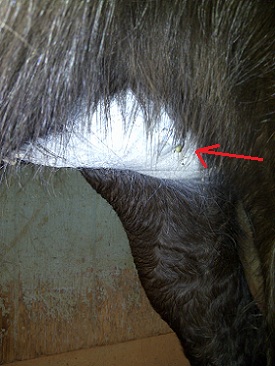
|
| Member: lsweeney |
Posted on Wednesday, Feb 8, 2012 - 3:48 pm: 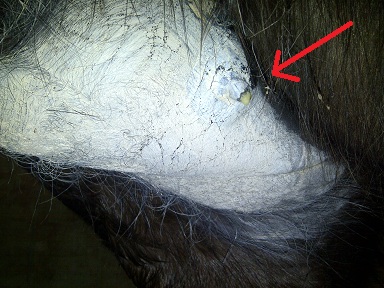
|
| Member: lsweeney |
Posted on Wednesday, Feb 8, 2012 - 3:49 pm: If I didn't know that this started with Pigeon Fever, I would say that it is Mastitis. And may be. I'll have to read up on it. Isn't Mastitis an infection in the mammary gland? |
| Member: lsweeney |
Posted on Wednesday, Feb 8, 2012 - 3:53 pm: Perhaps I should have read this first.Hot packing and milking out the affected mammary glands can be helpful however however this can be dangerous because of the painful gland. If at first the mare will not allow it, perhaps after a day or two of antibiotic and antiinflammatory therapy this can be accomplished. 
|
| Member: lsweeney |
Posted on Wednesday, Feb 8, 2012 - 3:55 pm: And no she is not pregnant. |
| Member: judyhens |
Posted on Wednesday, Feb 8, 2012 - 4:45 pm: I feel your pain! I have a friend who pretty much took her life in her hands trying to milk out an infected teat. Our son's mare developed mastitis following weaning. Was not real happy about having it milked until the antibiotics took effect and the infection got under control. I read a few articles that indicated that mastitis could occur with PF, but Dr. O. would be better able to confirm that. Maybe an antiinflammatory would help. PF is a real pain! Blessings, Judy |
| Member: lsweeney |
Posted on Wednesday, Feb 8, 2012 - 6:31 pm: Here's what it looks like without the poultice on it.You can see both teats on this picture, and you can really see how big the one is. 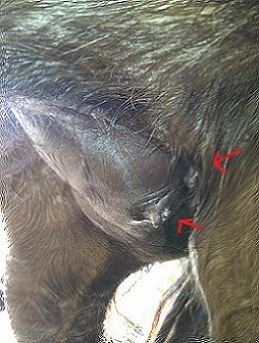
|
| Moderator: DrO |
Posted on Thursday, Feb 9, 2012 - 8:03 am: Hello Laurie,Sometimes it just seems like problems will never stop but continued attacking of each problem as it rears its head will eventually lead to success. As with any abscess, whether in the teat or elsewhere, your next move is to establish proper drainage of the purulent material followed by flushing. DrO |
| Member: lsweeney |
Posted on Friday, Feb 10, 2012 - 9:56 pm: Well, the ultrasound didn't show any clear path to any pocket that could be lanced. We are not giving her any antibiotics, but treating the fever with some banamine as needed.I have been able to slightly "milk" the abscess through the teat. So the saga continues on...... |
| Member: paul303 |
Posted on Friday, Feb 10, 2012 - 11:07 pm: What a trial. Good luck, Laurie. I've had better luck with hot soaks than poultices, although in between hot soaks, I've used poultices just to keep something going. It's also a rotten place to have to do hot soaks. They should probably be called "good and warm" soaks. And the more soaks, the better. Thanks for keeping us informed. |
| Member: judyhens |
Posted on Saturday, Feb 11, 2012 - 1:50 pm: If it is anywhere near as cold there as it is here (20s tonight and windy - cold for a native Texan!) I don't envy your soakings! Will keep you and your equine friends in our thoughts and prayers. Keep that water nice and warm!Judy |
| Member: vickiann |
Posted on Saturday, Feb 11, 2012 - 9:20 pm: What an ordeal, Laurie.Hang in there! |
| Member: suemc |
Posted on Sunday, Feb 12, 2012 - 10:46 am: Hello Laurie. Just reading up on your nightmare whilst I'm having my own again with my old girl's eyes.I can't offer advice as I know nothing of the condition but just knowing people care and are wishing you and your horses well sometimes can make the stress of it all that little bit easier Wishing you and your mare all the luck in the world |
| Member: lsweeney |
Posted on Wednesday, Feb 15, 2012 - 4:28 pm: Thanks for the support you guys!! Nikki's abscess is continuing to close up and healing nicely. I just had the vet out today for Myntje. We didn't ultrasound it again today. It doesn't look much different and her temperature has been normal across the last 4-4 days. I'm continuing to soak and express pus out of the teat. It's loads of fun.The vet wanted to get a second Titer test on the Pigeon Fever for Myntje (abscess in the teat) to see if it has changed much since the relatively low Titer test taken at UC Davis. If it hasn't changed much, her thinking is that we are dealing with mastitis and should possibly start her on some antibiotics? Thoughts? Nikki's titer test was 1.64 and Myntje was 1:32 from a few weeks ago. I will post Myntje's updated numbers when I get them. C. pseudotuberculosis SHI titers less than 1:8 are not considered significant, and probably represent cross-reactions with common environmental organisms. Titers > 1:256 have a high association with internal abscess formation. |
| Moderator: DrO |
Posted on Saturday, Feb 18, 2012 - 8:59 am: Hmmm if her indecision is such that she needs this information then I guess it should be done. Does the puss look the same (color and consistency) as the pigeon fever abscesses? Staining and microscopic exam the organisms can help support or rule out the type bacteria.DrO |
| Member: lsweeney |
Posted on Monday, Feb 20, 2012 - 3:10 pm: No results yet. I think somehow she was reacting to the long time the horse has had this abscess - a month and a half now, and if the titers had not changed substantially, that maybe we were dealing with mastitis now. I don't know that I follow the logic exactly, however, I didn't think it hurt to see if the titers had changed to make sure that there was no internal activity, especially when she started to run a fever.The concern with it coming out of the teat is that the hole isn't big enough to really drain the abscess. However, both UC Davis and this vet has ultrasounded the teat and didn't find any obvious track to lance. Her temperature was raised for only a couple of days, after the teat got really huge. It has since DrOpped and has been normal for about a week. In the meantime, I'm still soaking and milking the teat. I'm also getting good enough at it, that I'm considering getting a cow for fresh milk ;-) I also have her trained now, with carrots in my pocket. So she is more interested in when the next carrot is going to appear, then what I'm doing back there. The milk/pus is changing. The stuff from the rear of the bag is very clear, like non-fat milk. This area has now softened up and is no longer hard. The stuff from the top and front of the bag (where the bag is still firm and hard) is more pus like, and gooier. When I first started doing this, is was more yellow and lumpy. It takes about 15-20 minutes of milking, and I can completely drain everything it has to offer to where I don't get anything out of the teat. The picture below is from Friday. I think I'm making headway. It seems quite a bit smaller to me. |
| Member: lsweeney |
Posted on Monday, Feb 20, 2012 - 3:12 pm: The red arrow is where the far teat is located.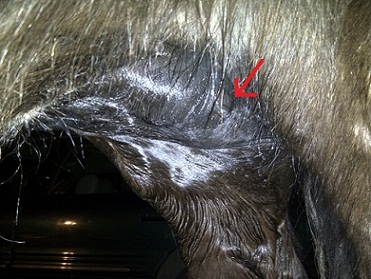
|
| Member: lsweeney |
Posted on Monday, Feb 20, 2012 - 3:24 pm: Here is what Nikki looks like now: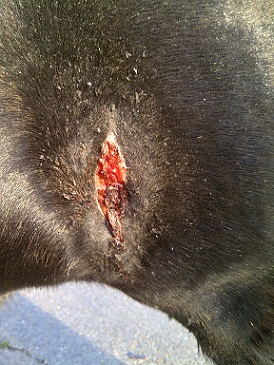
|
| Member: lsweeney |
Posted on Monday, Feb 20, 2012 - 3:47 pm: Just in case anyone is interested, you can get epsom salts in 50 lb bags...... 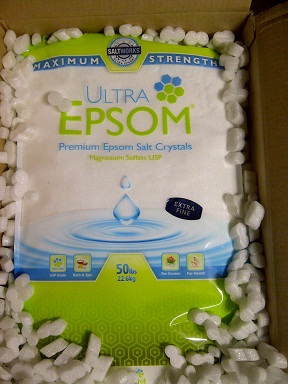
|
| Member: lsweeney |
Posted on Monday, Feb 20, 2012 - 4:27 pm: Just one more general question.What is the difference between an abscess in the teat caused by the pigeon fever bacterium vs. whatever infectious agent that causes mastitis. Is mastitis a general term for infection in the breast? Or is there a specific bug involved? |
| Moderator: DrO |
Posted on Wednesday, Feb 22, 2012 - 3:58 pm: Mastitis means inflammed mammary gland. Not only will any infectious organism qualify but noninfectious diseases like trauma and neoplasia can cause mastitis. Teats overly filled with milk to the point of discomfort is also referred to as mastitis sometimes.DrO |
| Member: lsweeney |
Posted on Wednesday, Feb 22, 2012 - 8:41 pm: We got the titer test back. 1:512 The last titer test from a month ago was 1:32 So not good news. However, the abscess continues to recede and I'm not getting much out with milking any more. There are still some hard spots in the udder about the size of two oranges. Down from a large football.My vet wants to start with a round of Rifampin (I believe this is what I heard.) I called UC Davis and they said that the bacteria can develop resistance to this drug, so they usually combine it with another antibiotic. However, the problem with this is that they may develop diarrhea, and the antibiotics can be life threatening in it of themselves. The vet at UC Davis is recommending that we take some general bloodwork now and see if there is any other indication that it is in any of the organs, or there is any other problem with the blood work. She also said that they could do an abdominal ultrasound to see if they could see any abscesses, but thought that first she would take a standard blood panel. The Titer test also took about a week to get the results. So we are looking at old news, closer to when she was running a fever. She has now not run a fever for about 1 week. She is otherwise bright, hungry and in good spirits. She didn't think another titer test now would produce definitive results, and suggested that if we were going to do this, to wait a couple more weeks. I suspect another option would be to ultrasound it again to see if there would be any benefit in lancing it. So Dr. O, would you like to weigh in? |
| Member: lsweeney |
Posted on Thursday, Feb 23, 2012 - 1:41 pm: 99.7 temp this morning. What I can get out of the teat now is yellowish water and it is not prolific. She is bright. Demanding carrots (banging her hoof on the feeder). No signs of wear and tear. The abscess is hanging lower, not as tight up in the groin. It almost swings, like a low hanging yam. Still hard in the center, but softer around the edges. Probably about half the size as when she spiked a fever.I've suggested that my vet talk to UC Davis and come up with a plan based on the various paths described above. In summary, her fever spiked on 2/8/12 when the abscess grew over night and started draining pus from the teat. The vet had me give her a gram of banamine for two days while her temp was elevated. It then went to normal since 02/10/12 forward. On 2/9/12 we ultrasounded it and it didn't have a path to lance. I have soaked and milked with good results since this time, getting as much as a 1/4 cup of pus from each milking. Now only yellowish watery fluid coming from teat, and it is no longer draining on its own. She has no edema. On 2/15/12 we drew blood for a titer test. Dr. O, do you have an opinion re: the titer result of 1:512 from the blood drawn on 02/15/12. Please see my previous post of the two different veterinarian opinions. Thank you! Laurie |
| Member: lsweeney |
Posted on Thursday, Feb 23, 2012 - 1:47 pm: Also, she was the first horse to get this in early January, so she has been fighting this since this time. |
| Member: lsweeney |
Posted on Thursday, Feb 23, 2012 - 10:51 pm: Anybody there? |
| Member: lsweeney |
Posted on Friday, Feb 24, 2012 - 5:19 pm: Anybody there? |
| Member: mrose |
Posted on Friday, Feb 24, 2012 - 7:55 pm: Hi Laurie. I've been reading all this just now. What an ordeal! Years ago we had a mare that came back from a breeding farm in Sacramento Valley area with Pigeon Fever. She developed an enormous abcess between her front legs and it took forever to heal. We also had an older mare with mastitis and that too took forever; at least it seemed so at the time. The vet said that it had been dry and windy in the valley and the organisms that cause Pigeon Fever were prevelent because of that; many more cases than normal. We lived at 8000' and had never seen a case before.I don't have any good advice other than watch your head when doctoring teats! But, you've already learned that!! I feel your pain though; what an ordeal. |
| Member: lsweeney |
Posted on Friday, Feb 24, 2012 - 10:05 pm: Thanks Sara.She is still not on antibiotics. I'm no longer getting thick pus from the milking, just a small amount of watery serum. There is still a hard mass in the center. My vet took blood tonight for a blood panel which is what UC Davis suggested before we put her on a long-term antibiotic regimen. She is going to check with UC Davis to see if it would hurt if we put her on less caustic antibiotics for the mastitis, and then check the titers in a couple more weeks (assuming that the blood panel comes back normal). |
| Member: mrose |
Posted on Saturday, Feb 25, 2012 - 12:11 am: I wonder if instead of stestemic antibiotic you could use that stuff in the tube people use on dairy cows when they have mastitis? Sorry I don't remember the name of it; but it seems to work wonders - not only on mastitis, but on small puncture wounds as well. It might be worth asking about IF you can get it into the teat. |
| Member: lsweeney |
Posted on Saturday, Feb 25, 2012 - 12:13 am: The only opening is her teat, so like a pin hole. |
| Member: mrose |
Posted on Saturday, Feb 25, 2012 - 12:40 am: Hmm...you might ask. The medicine comes in a tube with a syringe like nozzle on the end. Of course, you might need to wear a helmet while trying to squirt it up into the teat! |
| Member: lsweeney |
Posted on Saturday, Feb 25, 2012 - 12:24 pm: Exactly |
| Member: lsweeney |
Posted on Saturday, Feb 25, 2012 - 4:19 pm: The panel came back good with the only negative reading being that she was slightly anemic. |
| Moderator: DrO |
Posted on Saturday, Feb 25, 2012 - 7:04 pm: Hello Laura,I don't have much feeling for the titers you are getting and what they may be indicating as to your mastitis problem. I do find reading your posts confusing: is your horse getting better (in which case I would consider continuing to do what you were doing) or getting worse (in which case I would consider reevaluation of what you are doing)? If you would like to read more about rifampin use see HorseAdvice.com » Treatments and Medications for Horses » Antibiotics and Antimicrobials » Erythromycin and Rifampin. Just to emphasize, yes rifampin is most often if not always used in combination with other antibiotics. When in doubt I would council you follow the recommendations of those who can examine the horse directly. If you are not satisfied with their thoughts you should seek a second opinion based on a examination. No one can treat such a case as yours effectively by phone or internet. DrO } |
| Member: lsweeney |
Posted on Sunday, Feb 26, 2012 - 3:27 pm: At the time of my post from last week (and my question to you), the horse appeared to be improving externally, but the titer result which was a week old, indicated that there could be internal abscesses 1:512. I had conflicting opinions from my vet who was suggesting a long-term antibiotic treatment vs. the UC Davis vet who was hesitant to start an antibiotic regimen given the caustic nature of the antibiotics juxtaposed with her improved appearance. She was suggesting a blood panel first. So we did the blood panel, which came out fine except for slight anemia. My vet has a call into UC Davis to discuss a shorter-term antibiotic treatment to kill off the balance of the mastitis, as there is still some hard swelling there, but no pus drainage any more. |
| Member: lsweeney |
Posted on Sunday, Feb 26, 2012 - 9:00 pm: Abscess is starting fill again. So I don't think this is going to resolve by itself. I'm feeling another trip to have it ultrasounded is going to be in order.....
|
| Member: vickiann |
Posted on Monday, Feb 27, 2012 - 11:08 am: What a pain, Laurie.Hang in there. |
| Member: lsweeney |
Posted on Tuesday, Feb 28, 2012 - 4:53 pm: My vet doesn't think that there is a path for lancing and we have put her TMZ (I think) I'm still not getting any real pus out of it any more. Just in case anyone was wondering.....still soaking, poulticing and taking her temp everyday. It's normal. |
| Member: mrose |
Posted on Tuesday, Feb 28, 2012 - 5:51 pm: I feel for you - and the mare. Not fun! Hopefully the antibiotic will help her. |
| Member: frances |
Posted on Wednesday, Feb 29, 2012 - 1:29 am: Good luck with this Laura. Have you decided to ultrasound again? You really deserve a break by now. |
| Member: lsweeney |
Posted on Thursday, Mar 1, 2012 - 5:35 pm: I did suggest ultrasounding again, but my vet didn't think that we would get a path, especially since I have milked all of the pus out the tit so far. I think it does look like it is puckering up a little bit after several days of antibiotics. |
| Member: frances |
Posted on Friday, Mar 2, 2012 - 8:42 am: Let's hope so.... |
| Member: lsweeney |
Posted on Tuesday, Mar 13, 2012 - 6:38 pm: New development on the horse that was lanced at UC Davis, Nikki. Her wound was almost healed, but not closing up completely. I noticed a some pus coming out of it. It looks like it was pushing out the last bit in the form of toothpaste like white substance. I squeezed it out, cleaned it up, and that appeared to be it. Until yesterday, when I noticed some pus on her fetlock. There is a spot the size of a quarter where the hair is now missing, purple/pink/dotted skin, and pus that comes out when you press the skin. We soaked it in betadine and epsom salts. I then put a poultice on it to draw it out. This is the only spot I can find on her legs and she is not lame. Do I panic?For the other horse, she is still getting T-S antibiotic, the mammary gland abscess is smaller, but not gone, and I'm now using a vibrator on it in addition to soaking and massaging with epsom salts. The vibrator does seem to help in breaking up the hard spots in the udder. |
| Moderator: DrO |
Posted on Wednesday, Mar 14, 2012 - 7:26 am: I would not panic Laurie but I would advise having your vet come out and evaluate this new abscess. If you are having problems with noninfectious swelling exercise, massage, and yes I guess even vibration are all logical. However if there is still infection in the tissue this things may spread it about.DrO |
| Member: lsweeney |
Posted on Wednesday, Mar 14, 2012 - 3:31 pm: I have calls into UC Davis and my vet.I'm guessing that this is: ulcerative lymphangitis. I don't know if this automatically necessitates antibiotics? This horse has yet to be on any antibiotics. When the large abscess was draining, it created a skin infection where it dripped down the leg. I had put Swat on it, but apparently the bacteria was able to set up camp underneath it. Once I discovered this, (it's hard because we are sporting a thick winter coat), I removed all of the hair which was coming out in chunks, hosed it, cleaned it with betadine, antibiotic ointment and went to Desitin to protect the skin from the dripping abscess. This cleared it all up. So I'm going to do the same with this spot on the Fetlock. I just don't know if it is coming from an internal infection, instead of superficially in the skin. |
| Member: divamare |
Posted on Thursday, Mar 15, 2012 - 12:48 am: Good Heavens Laurie you are having a time of it. Your horses certainly are lucky to have such an attentive nurse maid. I sure hope you get speedier results soon that will allow you to take a break. !!! |
| Member: vickiann |
Posted on Thursday, Mar 15, 2012 - 5:42 pm: What an ordeal.Hope that this problem is soon resolved for you once and for all! |
| Moderator: DrO |
Posted on Thursday, Mar 15, 2012 - 9:23 pm: Laurie, I don't see from your posts evidence of ulcerative lymphangitis. For a description of this condition see HorseAdvice.com » Diseases of Horses » Lameness » Leg Swellings » Hot & Painful Legs. But that said I am not sure what you are looking at. Let me know what your veterinarian finds.DrO |
| Member: lsweeney |
Posted on Saturday, Mar 17, 2012 - 5:20 pm: Here is the spot on the leg that had an abscess above the stifle that was lanced on Nikki. I'm inclined to agree with you Dr. O. It has now been several days. The pus has finished draining, and now it looks like a skin infection in a small, localized place. I'm not convinced that it is NOT related to the Pigeon Fever bacteria, but from everyone that I have spoken to, including UC Davis, ulcerative lymphangitis is much more dramatic, with significant lameness and a stovepipe leg.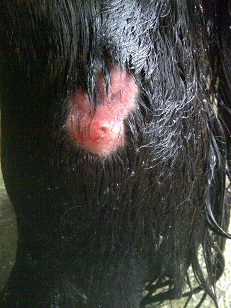
|
| Member: lsweeney |
Posted on Saturday, Mar 17, 2012 - 5:27 pm: Here is the abscess on Myntje's udder which started in early January. She is now on antibiotics TMP-SMZ (no rifampin) for the last couple of weeks, and while there is some shrinkage, it definitely is not going away any time soon. The white in the picture is clay poultice that didn't wash off.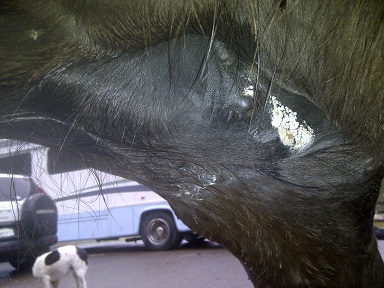
|
| Member: lsweeney |
Posted on Saturday, Mar 17, 2012 - 5:31 pm: Myntje's abscess has been ultrasounded twice. However, in speaking with my vet, we will probably take another pass at lancing it soon. |
| Member: lsweeney |
Posted on Saturday, Mar 17, 2012 - 5:39 pm: Here's another view of Myntje's abscess from the other side.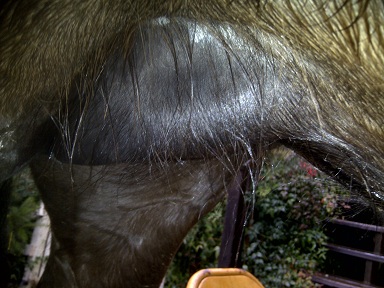
|
| Member: lsweeney |
Posted on Saturday, Mar 17, 2012 - 9:24 pm: Just cleaned out the fetlock wound. Quite a bit of pus when squeezing it. Perhaps a good teaspoon full. Cold hosed it, cleaned and soaked with betadine and epsom salts, and the dressed with triple antibiotic ointment, and Desitin on the surrounded skin/hair to protect it. |
| Member: lilo |
Posted on Sunday, Mar 18, 2012 - 10:19 am: What a mess. I feel for you, since it has been going on for so long. Hope everything clears up soon. |
| Moderator: DrO |
Posted on Monday, Mar 19, 2012 - 7:54 am: Laurie to effectively treat that spot on the leg I would open it wider so it can be thoroughly flushed, cleaned, and treated.DrO |
| Member: lsweeney |
Posted on Saturday, Mar 24, 2012 - 6:13 pm: I was out of town for a couple of days, but the leg wasn't ignored. It looked like it was drying up some, and perhaps healing. So while I understood the need to open it up, I thought we might be heading in the right direction. So there was no pus for several days. However, once again this morning, upon pushing on the area, pus oozed.So the following pictures shows, what it looked like uncleaned, with some pressure pushing out what was underneath. Followed by a clean shot from a distance, with a little more pus after pressure with my fingers. Followed by a picture of the wound after being cleaned, soaked, etc., after me taking an exacto knife and slightly opening up a couple of the larger nodules, recognizing that I'm not a vet, and I will have a vet treat it on Monday. Do we still think that this is not ulcerative lymphangitis since it looks a lot like the pictures and description of the skin now. She is still not lame, and no longer has any filling in the leg, though. Also, I'm getting nowhere fast with the other mare's abscess in the mammary gland, so I'm going to have her ultrasounded next week. The antibiotics that she is on, don't appear to be doing anything for us. Both horses still have normal temperatures. |
| Member: lsweeney |
Posted on Saturday, Mar 24, 2012 - 6:14 pm: 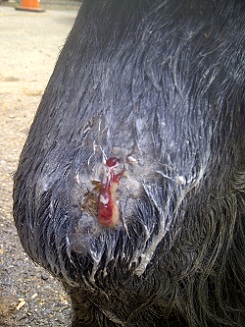
|
| Member: lsweeney |
Posted on Saturday, Mar 24, 2012 - 6:15 pm: 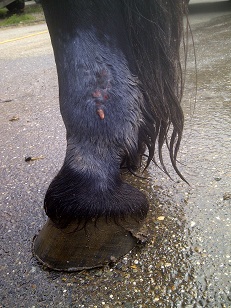
|
| Member: lsweeney |
Posted on Saturday, Mar 24, 2012 - 6:16 pm: 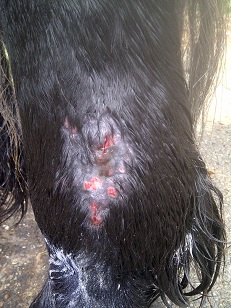
|
| Member: lsweeney |
Posted on Saturday, Mar 24, 2012 - 9:49 pm: Also, the pink dots that you see is what it looks like after it has been cold hosed. Those are openings on top of the nodules. Where it is redder in the picture is where I slightly opened the two larger nodules. Trust me, it was very superficial. |
| Member: lsweeney |
Posted on Sunday, Mar 25, 2012 - 1:28 pm: I talked to UC Davis, and I'm just trying to make it through the weekend (avoiding $200 per horse emergency charge) before I take them down on Monday.Tried something different. I took IceTight, epsom salts, Betadine and a little furazone and mixed it into a paste. I then coated the area and wrapped with vet wrap. (No plastic). My goal was to pull the moisture out of the nodules. There are nodules under the hair around the hairless area that I'm sure representing where it will be spreading next. The UC Davis vet said that the goal was to keep the infection away from the joint. Next morning it was perfect for what I was trying to accomplish. It was powdery when I pulled off the vet wrap, completely dry. (It's raining here.) All of the nodules that I had opened slightly with a razor blade, were flat and sucked out. The nodules that are developing still have fluid in them but had not grown. No pus. So my regime until I go to UC Davis is: cold hosing, followed by soaking in epsom salts and betadine, and then re-wrapping with my poultice concoction. Following this is a picture from the AM after I cold hosed the poultice off. The white dots are skin, not pus. |
| Member: lsweeney |
Posted on Sunday, Mar 25, 2012 - 1:30 pm: 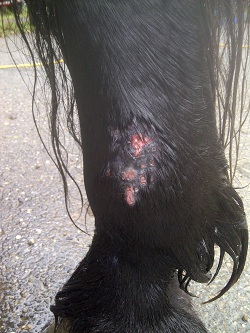
|
| Moderator: DrO |
Posted on Sunday, Mar 25, 2012 - 3:19 pm: It continues to look like a local infection or abscess rather than a generalized inflammation or infection of the lymphatics or other tissues (cellulitis) of the legs.DrO |
| Member: lsweeney |
Posted on Sunday, Mar 25, 2012 - 3:53 pm: OK, I was treating it more like I would scratches or rain rot, and that was not working. Drying it out seems to be the better approach. It is not sitting on top of the skin like the scabs you get with rain rot. It is in and under the skin with nodules that are like pimples, that grow, get infected and then pop open with pus. You think you have nailed one and then others pop up. |
| Member: vickiann |
Posted on Sunday, Mar 25, 2012 - 7:20 pm: What a nasty mess.Friends and I have recently had some relief with using poultices made from the Dynamite product, Miracle Clay. In fact, I used it to help tame down an infected cat bite on my own hand. I've used it on horses as have some of my friends with good results. Wishing you a successful outcome to this ordeal! |
| Member: judyhens |
Posted on Monday, Mar 26, 2012 - 2:32 pm: Good luck! Our thoughts and prayers are with you!Judy |
| Member: lsweeney |
Posted on Tuesday, Mar 27, 2012 - 3:50 pm: Thanks guys!!!OK I'm back from UC Davis. They did a complete blood panel on both horses. They didn't feel another titer test would yield much information. Myntje - Mammary gland abscess: On Myntje's mammary gland, there is nothing to lance. It is just one solid mass that could be scar tissue. They took some of the serum from the teat to culture. They said both the teat serum and the ultrasound images were not exactly normal. So I'm interested in the culture results that I don't have yet. Blood work and temperature all normal. We asked if the scar tissue in the udder would impact Myntje foaling (maiden mare). She wasn't sure. I will have to decide if I want to break another young horse in my late 50s if I breed her. ;-) That's probably a bigger question! They gave me another couple of weeks of antibiotics for Myntje while we wait for the culture. With this dosage, she will have been on TMS for 6 weeks. Nikki - Fetlock skin infection on same leg as lanced Pigeon Fever abscess above stifle: They were concerned with Nikki's skin infection on the fetlock given the close proximity to the joint, in the leg, etc. They were also suspicious of Pigeon Fever involvement. They confirmed that she was not lame, and then ultrasounded it looking for any foreign bodies, like a splinter, etc. They didn't find anything that would point to an injury nor did they find any foreign bodies. They took a culture of the pus and a biopsy of one of the nodules/pimples. They put a wrap on it with instructions to leave it there for 3 days, and then gave me a medicated poultice to put on it with instructions to wrap it for another 3 days. They gave me TMS antibiotic for 7-10 days. This will be the first time that Nikki will be on antibiotics. Her bloodwork and temperature was normal. *************************** So nothing to point to internal abscesses on both horses which was a priority for me to find out. I will update again when we get the cultures and biopsies back. I'm really glad that we went down there because I have been staring at this udder for months now thinking if we could only just open it up...... I can stop doing that now. I wonder if they have breast reduction surgery for horses? Laurie |
| Member: lsweeney |
Posted on Wednesday, Mar 28, 2012 - 1:10 am: This is the product that they instructed me to put on the fetlock skin infection:https://www.woundsupplyonline.com/curasalt-dressing-p/curasalt.htm Kendall Curasalt Sodium Chloride Dressing |
| Member: lsweeney |
Posted on Monday, Apr 2, 2012 - 2:42 pm: Update from UC Davis:Myntje (Mammary Gland Abscess): Nothing grew for a week in the culture, but something has started to grow now. It could be contamination. They are going to let it grow a little longer to see what it is. At this point they want me to continue the TMS for a few more days while they wait on this culture. In the absence of any results, they still feel it is scar tissue. The other remote possibility is cancer of some kind, but not likely given the Pigeon Fever infection. Nikki (Stifle and Fetlock abscess): They have confirmed that the Fetlock skin thing is the Pigeon Fever bacteria. The biopsy just showed aggravated tissue. However, they are going to take another slice of the biopsy and test one more time. They want her on another 2 weeks of TMS. The leg infection looks much better. I did get a little pus out of it yesterday, but the skin is flat now, and it is no longer growing outward. No more pimples. I'm feeling a little optimistic......knock on wood. |
| Member: lilo |
Posted on Monday, Apr 2, 2012 - 3:28 pm: Good luck, Laurie! |
| Member: lsweeney |
Posted on Monday, Apr 2, 2012 - 7:25 pm: Thanks!!! |
| Member: paul303 |
Posted on Wednesday, Apr 4, 2012 - 12:33 am: Wonderful job, Laurie, and...many thanks for the updates! |
| Member: lsweeney |
Posted on Sunday, May 6, 2012 - 4:21 pm: Hopefully, the final update on this one. The culture that had a spec of something growing after a week turned out to be Pigeon Fever bacteria. So there was still a little of this stuff hanging around in Myntje's udder. We kept her on antibiotics for another 3 weeks.They kept Nikki on antibiotics also for another 3-4 weeks. TMS. I will post some after pictures. |
| Member: lsweeney |
Posted on Sunday, May 6, 2012 - 4:44 pm: Nikki's stifle abscess - Can you see where it was?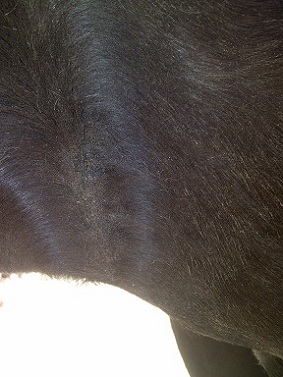
|
| Member: lsweeney |
Posted on Sunday, May 6, 2012 - 4:58 pm: Here's the fetlock abscess: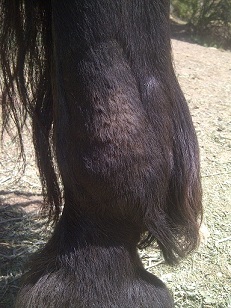
|
| Member: lsweeney |
Posted on Sunday, May 6, 2012 - 5:17 pm: Now, Myntje's udder is not quite the same. It has been ultrasounded 3 times and nothing is in it. It may be scar tissue. So far it hasn't tried to blow up again.I can live with a one big boob. 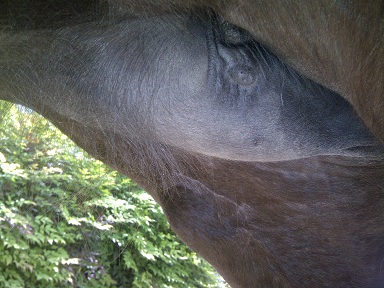
|
| Moderator: DrO |
Posted on Sunday, May 6, 2012 - 7:10 pm: I have recently found reports of PF complications including the abscessing > ulcerative lesions on the legs similar to what you have shown above. Your postings are a real testament to the patience and hard work it takes to work through a Pigeon Fever case and I hope others find help and comfort in treating their own cases.DrO |
| Member: paul303 |
Posted on Sunday, May 6, 2012 - 11:41 pm: What a fantastic job, Laurie. I'm grateful to have been able to follow this grueling ordeal. It's been an incredible learning experience. And, no, I can't tell where it was! |
| New Member: lbrnm |
Posted on Tuesday, May 8, 2012 - 5:25 pm: Laurie,Thank you so much for providing such detailed information throughout your entire ordeal. It is wonderful to see after pictures and to hear how cases are resolved. Nikki and Myntje certainly have a wonderful "mother". Kudos to you!! Would love to see pictures of them in their entirety, if possible. 
|
| Member: lsweeney |
Posted on Friday, May 11, 2012 - 2:57 am: Thanks for the responses you guys. Dr. O - The vets at UC Davis didn't like the looks of that fetlock. That poultice stuff (Kendall Curasalt) they gave me was quite effective along with the antibiotics. They had me wrap it for 3 days and just leave it alone. I found some articles from other vets on the web regarding this stuff being the best in treating infectious wounds. Unlike the abscesses that will burst and heal themselves, I'm curious what would have happened to the fetlock infection if ignored. It was very different than the abscesses.Nicole - I will look for some pictures of their whole bodies! Here's the best part: For a good 5 months these horses have been on a regimen of temperature checking, epsom salt soaking, eating antibiotics, etc. To keep their spirits up there were lots of treats, rewards and molasses to make the medicine go down. Well, now they line up in front of my garage and wait for their "treatment". They both are easy keepers, and I have had to fight to keep their weight down, so anything sweet is a real treat for them. They are so pathetic now. They just stand there with this look like, "don't you need to take my temperature or something". "Haven't I been good just standing here - I think I deserve a reward." "Don't you want to feel my mammary gland"? "Don't you have some awful stuff that I should eat soaked in molasses?" It's hysterical. Since our recovery, Nikki has had a mild hoof abscess that popped at the heel. Now she is covered with hives and huge welts. So those will be the pictures I will take tomorrow and post. It's not pigeon fever. My Arab is also involved this time. I think it may be reactions to mosquitos. Ahhh, the joys of horse ownership...... |
| Member: lsweeney |
Posted on Friday, May 11, 2012 - 5:25 pm: Important take aways from my experience with Pigeon Fever:I would try to avoid antibiotics unless absolutely necessary. They may end up exacerbating the problem and not help the abscesses come to a head. Additionally, the horse may not tolerate the antibiotics well and they have to be on them for a long time. We never went to the more caustic antibiotics. If the horse starts to react to the antibiotic, you may end up with two problems. You also may create a resistance issue with the bacteria. Watch for fevers, general "off" behavior, anything that would indicate that the infection might be moving internally instead of externally. While a titer test will confirm the presence of the Pigeon Fever bacteria, the titer levels themselves are not absolutely indicative of whether you have external or internal abscesses unless they get crazy high. There are a lot of articles on the internet and specs on the blood tests that state that over 512 indicates that you may have an internal abscess. This is old information. The UC Davis vets threw around levels like 10,000 to confirm an internal abscess. In the end, the most valuable tests were blood panels and monitoring fibrinogen levels. If internal abscesses are present, it is more likely that you will have various organs impacted, with symptoms of this showing up on the blood test results. So I started to really rely more on how the horse was feeling, was there a fever present and what do the blood tests tell us. As far as treating the abscesses, I was told that at the first sign of the abscess trying to drain, that this is the time to lance it. I suspect that if I had waited long enough on Nikki's abscess that it might have eventually erupted, but she was infinitely more comfortable after it was lanced surgically. (Much like a hoof abscess.) Good luck, and I hope to never experience this again!!! |
| Member: lsweeney |
Posted on Friday, May 11, 2012 - 6:19 pm: For Nicole:Here is my husband soaking Myntje's mammary gland in the snow. Doesn't he look happy! 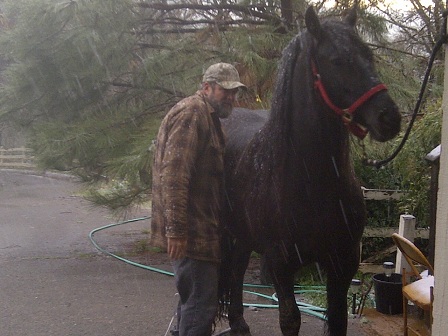
|
| Member: lsweeney |
Posted on Friday, May 11, 2012 - 6:22 pm: 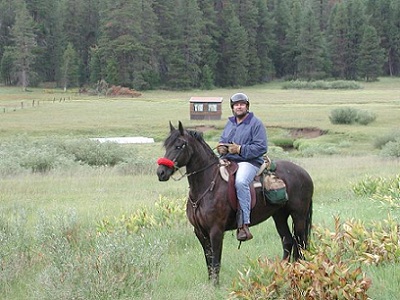 Here is Nikki on a camping trip. |
| Member: lsweeney |
Posted on Friday, May 11, 2012 - 6:25 pm: Here is Myntje on a camping trip.
|
| Moderator: DrO |
Posted on Tuesday, May 15, 2012 - 9:52 pm: Laurie,Your summation is spot on. DrO |
| New Member: lbrnm |
Posted on Wednesday, May 16, 2012 - 4:17 pm: Oh Laurie! They are both so beautiful!!! Thank you for posting pictures of them. :D |
| Member: natalya |
Posted on Wednesday, May 16, 2012 - 6:13 pm: Laurie,This is what happened to our rescued Arabian with infection on a fetlock left untreated. She became 3 legged hors for a long time, then brought up to our vet clinic to put her down do to infection went out of hand. This is when our trainer rescued her. Now, 5 year later, she is lost almost all her bone mass and currently is breaching. She was my daughter’s barrels horse till last year when she went lame with another infection in a same place (it took 3 months to rupture this time) Vet took x-rays and there was a mess do to old infection( that’s when we found out that infection went to the bone) We being told she is a pasture sound and light riding is ok. Her fetlock is double size of normal always and hard to touch. So that a good thing you were on top of it. I'm glad you babies have a good mom |
| Member: lsweeney |
Posted on Sunday, May 20, 2012 - 12:48 am: Thank you for the complements Nicole! These horses have been very good to us. We have lots of plans this summer for outings!.Thank you Dr. O. By Jove, I think I've got it!!! Natalya - I'm so sorry to hear your story. It is really scary that these bugs are becoming so powerful and resistant to treatment. While I will take a lot of credit for being on top of this infection, I will say that I'm pretty impressed with the body's ability to defend itself. It's a shame, Natalya, that in your case it looks like the infection took quite a toll. Laurie |
is The Horseman's Advisor
Helping Thousands of Equestrians, Farriers, and Veterinarians Every Day
All rights reserved, © 1997 -
